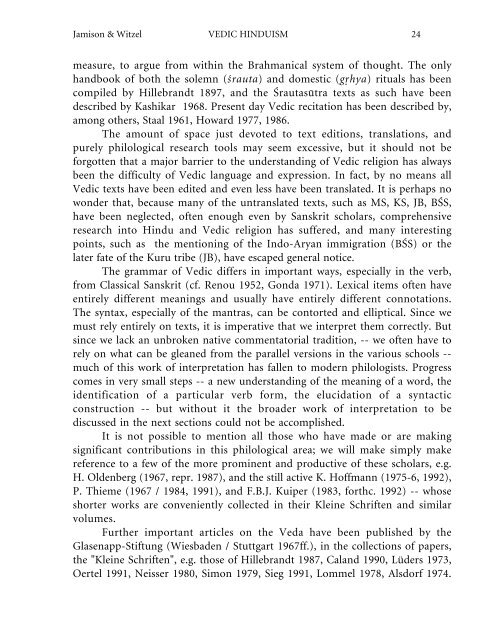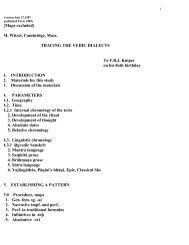VEDIC HINDUISM by S. W. Jamison and M. Witzel - people.fas ...
VEDIC HINDUISM by S. W. Jamison and M. Witzel - people.fas ...
VEDIC HINDUISM by S. W. Jamison and M. Witzel - people.fas ...
Create successful ePaper yourself
Turn your PDF publications into a flip-book with our unique Google optimized e-Paper software.
<strong>Jamison</strong> & <strong>Witzel</strong> <strong>VEDIC</strong> <strong>HINDUISM</strong> 24<br />
measure, to argue from within the Brahmanical system of thought. The only<br />
h<strong>and</strong>book of both the solemn (śrauta) <strong>and</strong> domestic (g�hya) rituals has been<br />
compiled <strong>by</strong> Hillebr<strong>and</strong>t 1897, <strong>and</strong> the Śrautasūtra texts as such have been<br />
described <strong>by</strong> Kashikar 1968. Present day Vedic recitation has been described <strong>by</strong>,<br />
among others, Staal 1961, Howard 1977, 1986.<br />
The amount of space just devoted to text editions, translations, <strong>and</strong><br />
purely philological research tools may seem excessive, but it should not be<br />
forgotten that a major barrier to the underst<strong>and</strong>ing of Vedic religion has always<br />
been the difficulty of Vedic language <strong>and</strong> expression. In fact, <strong>by</strong> no means all<br />
Vedic texts have been edited <strong>and</strong> even less have been translated. It is perhaps no<br />
wonder that, because many of the untranslated texts, such as MS, KS, JB, BŚS,<br />
have been neglected, often enough even <strong>by</strong> Sanskrit scholars, comprehensive<br />
research into Hindu <strong>and</strong> Vedic religion has suffered, <strong>and</strong> many interesting<br />
points, such as the mentioning of the Indo-Aryan immigration (BŚS) or the<br />
later fate of the Kuru tribe (JB), have escaped general notice.<br />
The grammar of Vedic differs in important ways, especially in the verb,<br />
from Classical Sanskrit (cf. Renou 1952, Gonda 1971). Lexical items often have<br />
entirely different meanings <strong>and</strong> usually have entirely different connotations.<br />
The syntax, especially of the mantras, can be contorted <strong>and</strong> elliptical. Since we<br />
must rely entirely on texts, it is imperative that we interpret them correctly. But<br />
since we lack an unbroken native commentatorial tradition, -- we often have to<br />
rely on what can be gleaned from the parallel versions in the various schools -much<br />
of this work of interpretation has fallen to modern philologists. Progress<br />
comes in very small steps -- a new underst<strong>and</strong>ing of the meaning of a word, the<br />
identification of a particular verb form, the elucidation of a syntactic<br />
construction -- but without it the broader work of interpretation to be<br />
discussed in the next sections could not be accomplished.<br />
It is not possible to mention all those who have made or are making<br />
significant contributions in this philological area; we will make simply make<br />
reference to a few of the more prominent <strong>and</strong> productive of these scholars, e.g.<br />
H. Oldenberg (1967, repr. 1987), <strong>and</strong> the still active K. Hoffmann (1975-6, 1992),<br />
P. Thieme (1967 / 1984, 1991), <strong>and</strong> F.B.J. Kuiper (1983, forthc. 1992) -- whose<br />
shorter works are conveniently collected in their Kleine Schriften <strong>and</strong> similar<br />
volumes.<br />
Further important articles on the Veda have been published <strong>by</strong> the<br />
Glasenapp-Stiftung (Wiesbaden / Stuttgart 1967ff.), in the collections of papers,<br />
the "Kleine Schriften", e.g. those of Hillebr<strong>and</strong>t 1987, Cal<strong>and</strong> 1990, Lüders 1973,<br />
Oertel 1991, Neisser 1980, Simon 1979, Sieg 1991, Lommel 1978, Alsdorf 1974.

















